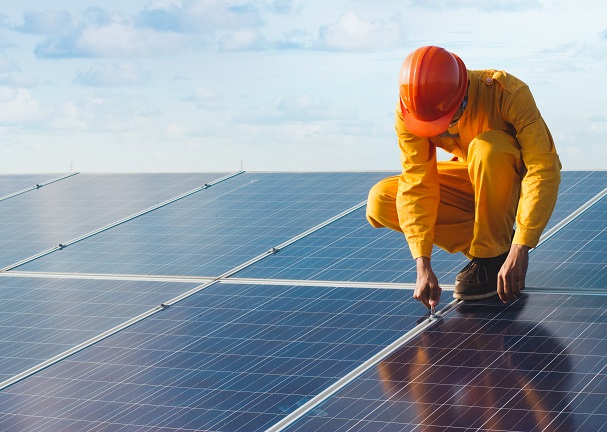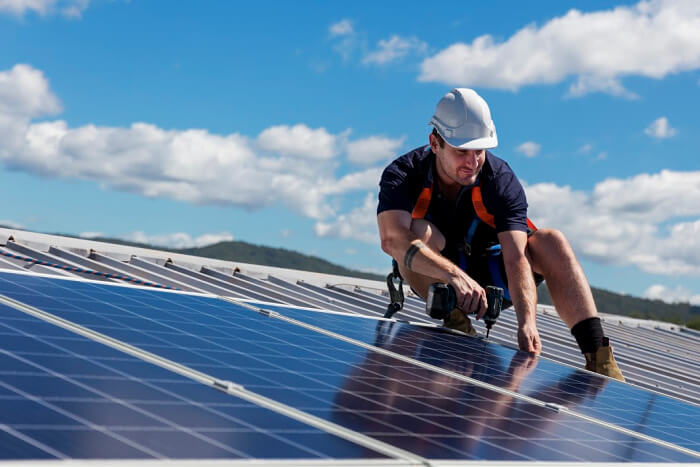
Effcient plant performance in the expert hands of SOLAR LOGICS
The fast growing utility-scale PV industry in India demands well managed operation & maintenance (O&M) services to keep plant performance at par with the needed expectations as well as applicable regulations. As utilities embrace and rely on solar PV grid-connected plants for both commercial and industrial applications, have the capabilities as well as experience in all aspects of solar plant O&M to help deliver optimal power.
Operations and Maintenance (O & M) is a set of activities that allow a solar PV power plant to optimally produce energy. There are several different approaches to solar O&M, such as Preventative maintenance or the routine inspection and servicing of equipment to avoid breakdowns and needless production losses.


An Operations and Maintenance (O & M) program is a formulated plan of training, cleaning, work practices, and surveillance to maintain asbestos-containing materials (ACM) within buildings in good condition. The goal is to minimize exposure to asbestos fibres, for all the occupants or residents of the building.
Preventive Maintenance Packages
- Regular cleaning of solar panels
- Regular cleaning of solar panels
- Frequent maintenance of thermal-based components
- Yearly service of HT side equipment
- Diagnostic testing for low power production
- Circuit testing
- IV curve tracing
- Thermal imaging
- Earth value measurement
- Retro commissioning
- Data acquisition system check
- Warranty management
Uptime Management
- Automatic string level visual alarms
- Real time data collection
- Monitoring energy production (daily basis)
- Effective data interpretation
- Mismatch characterization
- Solar Resource Management and Prediction
- PV system monitoring systems
- Trending and Analytics for continuous improvement
- Critical and non-critical reactive repairs
- Spare parts and inventory management
General checks
While a solar plant is being installed, engineers at SOLAR LOGICS prepare a schedule for preventive maintenance. This includes, but is not limited to, adjustments, cleaning, lubrication, repairs, replacements, and the extension of equipment life. At least twice a year, O&M personnel conduct a general inspection of the installation-site.
- Ensure roof drainage is adequate, roof drains are not clogged and confirm that there are no signs of water pooling near the array
- Ensure roof penetrations (if any) are watertight
- Check for ground erosion near the footings of a ground mount system
- Effective data interpretation
- Confirm electrical enclosures are only accessible to authorised personnel
- Check for corrosion on the outside of enclosures and the racking system
- Check for cleanliness throughout the site to ensure that there is no debris in the inverter pad area or elsewhere
- Check for loose hanging wires in the array
- Check for signs of animal infestation under the array
Specific checks
Apart from the basic checks, some specific checks are undertaken as part of the preventive maintenance:
Modules need the maximum amount of preventive maintenance, and cleaning activities are majorly concentrated around them.
In normal conditions, when there isn’t too much dust or dirt, cleaning is carried out on a fortnightly basis. However, in dusty areas such as Rajasthan, the cleaning frequency is increased to once a week.
The cleaning of the modules is performed keeping in mind the TDS (total dissolved solids) levels, water specifications and certain wiping details. In India, the TDS level of the water needs to be at least below 250 parts per million (ppm). The chlorine (less than 250 ppm) and calcium (less than 250 ppm) level of the water, as well as the electrical conductivity, is considered while carrying out the cleaning. Water quality is tested after every six months to ensure that set standards are maintained.
Brushes without hard bristles (say fibre brushes) are used for cleaning. A low-quality brush, like one with metal bristles, could negatively impact the glass surface of the modules. In some cases where hard substances like bird droppings have gotten stuck on the module, engineers use detergent to clean the surface. However, the detergent is not highly concentrated and has very high-water content.
Technicians at SOLAR LOGICS are currently in the process of developing automated cleaning systems. In the sprinkle-type cleaning system, nozzles will be placed on the module itself, and it will automatically start the system using remote monitoring, pressurise the water, and pour it over modules. It would be particularly useful when it is hard to install a water source at the site. However, this would be a costlier way to clean when compared to deploying someone at the site.
Post extensive cleaning, modules are wiped off properly to ensure no stain is left to avoid affecting the generation capacity. Since SOLAR LOGICS takes up the responsibility of maintaining the plant, our engineers make arrangements for Ultra Poly Vinyl Chloride (UPVC) conduit pipes to ensure water supply. After the system returns to steady-state temperature (i.e. there is no remaining impact from the cooling effect of wash water), the current produced is noted along with weather conditions including temperature, irradiance etc. This maintenance work is recorded in the log book, and the production of the clean system to the previous production values is compared.
Most German-make inverter manufacturers recommend servicing the inverter on a quarterly basis. However, SOLAR LOGICS Energy carries out servicing on a monthly basis as there is a lot more dust in India compared to other countries. The ventilation is provided via a filter, and this filter needs to be frequently cleaned. Therefore, usage of high-quality filters is advantageous. As part of preventive activities, our engineers check he voltage of the string inverter and record it in the periodic log book. This gives an understanding of voltage fluctuations if any.
Under preventive measures, we ensure that there is no gap between the male and female connector pipes. Any gap, irrespective of the size, could cause a fire and damage the modules. Separately, off-takers can install a “check” meter of equal or higher accuracy with reference to the main meter to cross-check the production level on a monthly basis. All readings have to be, more or less equal, with a 2-3% correction allowance.
For transformers at the site with installed capacity in megawatts, parameters such as the operating temperature, OTI (oil temperature), WTI (winding temperature), and oil level are monitored daily. If there is any internal disturbance in the transformer, it reflects in these parameters which are monitored at least three times in a day (at 11 AM, 02 PM and 04 PM as solar power is generated at its peak during these slots). The transformer has to be cleaned thoroughly once in six months. SOLAR LOGICS Energy conducts IR test and cable yearly to check the transformer performance.
To ensure that the plant is working smoothly (i.e. without any shutdown), the same has to be sealed properly. Else, rats and other rodents can enter, and get electrocuted. This, in turn, can cause a short circuit, and affect the entire plant. Many people are not aware that even high-pressure water can damage the modules. If the water stream is too strong, our team will place the outlet at a farther distance.
solar power plant constantly needs to be monitored to detect breakdowns and optimise its operation. The same function could be performed either on-site or from a remote location wherein we retrieve all the data either from the inverter or from communicating equipment (probes, meters etc.).

